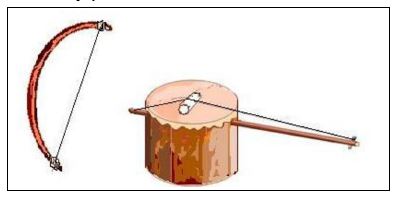String Instruments
Fiddle
Parts Of A Fiddle And Their Functions
Tuning A Fiddle
Care And Maintenance Of String Instrument
Techniques Of Playing String Instruments
Making Of A Fiddle(project)
Playing In An Instrumental Ensemble

String Instruments
- Are musical instruments that have strings.
- Produce sound by
- Plucking
- Strumming
- Rubbing the strings
- String instruments can have one, two or more number of strings.
- A string instrument with one or two strings is called fiddle.
- There different types of string instruments found among the Kenya communities.
- Each instrument has specific community of origin.
String Instrument Community Of Origin 1 Shiriri or ishiriri or silili Abaluhya 2 Litungu Abaluhya 3 Limoyi Abaluhya 4 Ongengo Abagusii 5 Obokano Abagusii 6 Nderemo Agikuyu 7 Wandindi Agikuyu 8 Entono Abakuria 9 Ekegogo Abakuria 10 Iritungu Abakuria 11 Orutu Luo 12 Uta Mijikenda 13 Uta wa wathi Akamba 14 Mbeve Akamba 15 Adeudeu Iteso 16 Mwazigizi or zeze Taita 17 Kimengeng Kalenjin 18 Pukan Pokot 19 Chepkongo/chemonge Kipsigis 20 Nyatiti Luo Luo Fiddle
Fiddles are string instruments that have one or two strings
Fiddle Community 1 Orutu Luo 2 Mbeve Akamba 3 Ekegogo Abakuria 4 Mwazigizi or zeze Taita 5 Ageregeret Iteso 6 Ishiriri Abaluhya 7 Wandindi Agikuyu 8 Kimeng’eng’ Kalenjin 9 Ong’eng,o or Otete Abagusii
Parts Of A Fiddle And Their Functions
- Arm/neck - for holding and supporting the instrument when playing it.
- String -it is plucked or strummed to produce sound.
- Resonator - makes the sound louder.
- Membrane/skin - used to cover the resonator.
- Bridge - used to make the sound clearer by separating the string from the skin or membrane.
- Tuning peg - used to loosen or tightening the strings to produce the desired sound.
- Bow - used to play the instrument.
Tuning A Fiddle
- Tuning is the process of adjusting the pitch of one or many tones of a musical instrument or getting it ready so that it is played it will sound at the correct pitch.
- String instruments are tuned to produce the desired sound.
To tune a fiddle, identify the string and also identify the sound that you desire to produce. - A fiddle can be tuned by
- Loosening the tuning peg
- Tightening the tuning peg
Care And Maintenance Of String Instrument
- Dust the parts of the instruments using a piece of cloth. Handle the string with care
- Always use the arm of the instrument when carrying it.
- Always check your string instrument before playing it
- Replace word out or damaged parts of a string instrument
- Store it in a dry place free from dust and moisture
- Keep your instrument away from dust by putting it in a protective bag
- String instrument can be stored by hanging them on a wall or placing them in a cool and dry place where people cannot step on them.
- Avoid storing your instrument near walking paths because people passing by may knock them.
NB: when string instrument are cared for and maintained well, they last longer and produce good sound.
Techniques Of Playing String Instruments
- Bowing
Rubbing the instrument using a bow.
Bow: is made using a sisal thread tied on both ends of curved stick.
Types of musical bow
- Groud bow- eg. Nderemo by Kikuyu
- Mouth bow- eg Obokano by Kuria
- Hunters bow- eg Entono by Kuria
- Plucking
- Involves pulling and releasing the string using the fingers.
- Holding
- Every string instrument has a specific way in which it is held when playing.
- When a string instrument is not properly held when playing, it may not produce the desired sound.
Making Of A Fiddle(project)
- Collect tools and materials
- Making the arm or neck
- Fixing the tuning peg
- Preparing the resonator
- Fixing the arm or neck to the resonator
- Fixing the string
- Preparing the bridge
- Preparing the bow
- Tuning and play to test
Appreciating The Role Of A String Instruments
Playing In An Instrumental Ensemble
- An ensemble is a group of people who performs instrumental or vocal music together instruments being played together
- An instrumental ensemble consists of a group of instruments being played together
- An instrument can be percussion instruments, winds instruments or string instruments
Download Kenyan Indigenous Musical Instruments - Music CBC Grade 6 Notes.
Tap Here to Download for 30/-
Get on WhatsApp for 30/-
Why download?
- ✔ To read offline at any time.
- ✔ To Print at your convenience
- ✔ Share Easily with Friends / Students


